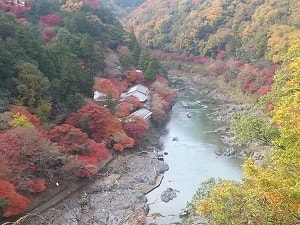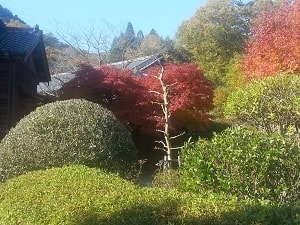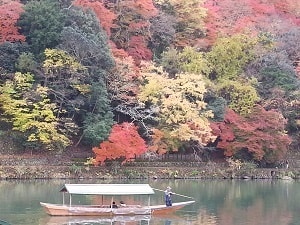Late November Autumn Leaf Viewing Tour
(As at 1st July we have stopped taking additional bookings for our
November Autumn colours tours.)
The following is a brief outline of the tour we have designed for the second
half of November. A more detailed schedule is available on request.
Saturday 16th November - Tokyo: We aim to either meet our guests at
the airport and assist with your transfer to our hotel in Tokyo, or provide
detailed instructions when that is not possible. Options for the day depend on your time of arrival,
and we can account for guests arriving in the days ahead of the tour as well. Generally
the first day is treated as an "arrivals day" with free time to explore the local area.
Typically, we use a centrally located hotel in Shinjuku.
Sunday 17th November - Tokyo: Start the day with a visit to Asukusa
and the oldest temple in Tokyo. The impressive Kaminarimon ("Thunder gate")
marks the entrance to the temple along with Hozomon and a five story pagoda. An
array of stalls lines Nakamise Street.
Departing Asakusa we then head to Ueno which provides some good options and
variety for lunch adjacent to the expansive Ueno Park. The park also contains
several museums (including Tokyo National Museum that we will visit) and Tokyo
Zoo (optional, one of the main attractions are the giant pandas) and the
beautiful Tōshō-gū shine that enshrines the first Shōgun of the Tokugawa
Shogunate.
Monday 18th November - Tokyo: Commence the day with a visit to the
Meiji Shrine. As the Meiji Restoration was an important period in Japan's
history we explain some of the historical elements of the change from feudalism
to the modern era before visiting the shrine buildings located in a central
Tokyo forest. As the shrine is adjacent to Harajuku, we then walk through
Takeshita Street, which is a trend-setting shopping area for Tokyo youth.
Leaving Harajuku there is a distinct transition as we move to the nearby
upmarket shopping district of Omotesando
For the afternoon, a trip across town to Hamamatsucho and a short walk to the
Hama Rikyu Gardens (one of the central Tokyo attractions that remains open on
Mondays).
As an attractive
landscape garden it sits between Tokyo Bay on one side and the skyscrapers of
Tokyo on the other.
Tuesday 19th November - Tokyo to Nagano: Departing from
Tokyo by shinkansen (bullet train) head towards the Japanese Alps to Nagano.
Aiming for a midday arrival, sample the local soba noodles before visiting Zenkoji
Temple, one of the most important and popular temples in Japan founded in the
7th century and houses the first Buddhist image in Japan (552CE).
For our stay in Nagano we head to the small onsen (hot spring) town of Togura/Kamiyamada
for a stay at a traditional Japanese Inn. This experience is complete with keiseki
dinner, onsen (hot spring baths) and futons.
Wednesday 20th November - Nagano: After breakfast, head to Nagano
station and take the express bus to Jigokudani Monkey Park. Depending on the
weather it could be cold (maybe snow). There is a walk of approximately 2km to
the "snow monkeys". Those not wanting to visit the rural area around
Jigokudani can either have a relaxing day in Togura or additional free time
exploring Nagano city.
Thursday 21st November - Nagano to Takayama: Departing Nagano we head to Matsumoto
arriving mid-morning to allow time to visit the castle and get lunch before
catching the afternoon bus to Takayama.
The Matsumoto Castle is a "flat-land" castle designated a National Historic
Site. One of the few remaining original castles in Japan from the Edo Period, it
was to be destroyed in 1872 on orders of the Meiji Government but, was saved
from destruction by the efforts of the local population. The six-story
main keep includes a display of guns and armour on the second floor.
Departing Matsumoto there is a road connection of approximately 100km to link
to the mountain town of Takayama. This scenic route winds though the Japanese
Alps, taking approximately 2.5 hours
Friday 22nd November - Takayama: Explore the town and its easy walking courses; enjoy
the local morning markets or visit one of the several small museums and temples
scattered around the town. Takayama is famous for its woodworking and its
biannual floats festival (matsuri). A visit to the Festival Floats Exhibition
Hall is a recommended stop on our tours. An additional stop we encourage is to
the "Showa" period museum. The Showa period covered December 1926 to Jan
1989 and the museum is a great place for nostalgia and a look back to a period
in history many people remember fondly.
After lunch visit the Hida Folk Village, an open air museum featuring gasho
style buildings with their unique steep thatched-roofed houses. This provides a
different range of historic buildings to those found at the World Heritage site
of Shirakawa-go.
Saturday 23rd November - Takayama to Kanazawa: Continuing our journey across Japan's
biggest island (Honshu), travel along the scenic Miyagawa River to Toyama before
a short shinkansen ride to Kanazawa.
The local Omi-cho fresh food market provides a good option for a fresh
sushi/sashimi lunch. Time in the city allows for visits to the beautiful
Kenrokuen Gardens (one of the top three gardens of Japan) and Kanazawa Castle
Park. The city also boasts the 21st Century Museum of Contemporary Art with an
interesting rage of exhibits .
Sunday 24th November - Kanazawa to Hiroshima: Departing Kanazawa, we travel south along the coast before cutting inland though
the alps and to Japan's second largest metropolis Osaka. Transferring at Osaka,
we re-join the shinkansen network for the trip south to Hiroshima.
With an afternoon arrival there is time to visit the Peace Park and the Peace
Museum. An alternative is the Hiroshima Castle (there is a samurai museum inside
the rebuilt castle). The city also boasts extensive covered shopping areas, and
is famous for its style of okonomiyaki (a type of Japanese pancake).
Monday 25th November - Hiroshima:
Taking advantage of our full day in Hiroshima we have time to explore a couple
of different destinations. The main attraction for the day is Miyajima Island
and its Itsukushima Shrine. This is the location of the famous 'floating' torii
gate. Also on the island we can use the ropeway (cable car) and head to the top
of Mount Misen for views across the Seto inland sea. If feeling energetic, the
walk back down the mountain provides some good viewing and vantage points
(otherwise we can get the ropeway back down).
An option for the start of the day is to visit Iwakuni and the famous
Kintai-kyo Bridge. Beyond the bridge is an interesting array of attractions
including stores selling more than 150 flavours of ice cream (as featured on TV), Kikko shrine and a selections of older style buildings and
gardens. We find this area provides an opportunity to see a more
'down-to-earth' side of Japan than the more manicured and established temples
and shrines in locations like Kyoto or Nara. Naturally if the group
decides on the Iwakuni visit, it will reduce the time at Miyajima.
Tuesday 26th November - Hiroshima to Kyoto: Leaving Hiroshima, we head north by
shinkansen to Kyoto. On the way we have an opportunity to visit Himeji and its
world famous castle, one of the finest examples of Japanese castle architecture.
With the stop at Himeji taking a couple of hours, we arrive in Kyoto - the
historic old capital of Japan - late afternoon. This still gives us time to
visit the very accessible Fushimi Inari Shinto shrine with its famous 10,000
torii gates (there are closer to 32,000). The walk to the top of Inari Yama (to see all 10,000!) takes a
couple of hours and is definitely optional.
Wednesday 27th November - Kyoto: The day begins with a visit to Nijo Castle (the
palace buildings are one the best surviving examples of castle palace
architecture of Japan's feudal era). From Nijo we then head to the "Golden
Pavilion" Kinkaku-ji in the north-west of the city.
From Kinkaku-ji, we travel across the city to the beautiful Arashiyama
district, a famous autumn leaf viewing location. At Arashiyama we enjoy the view across the Oi River from the
Togetsukyō Bridge. Among the famous sights in the area is the Sagano bamboo grove (although the large number of tourists makes it hard to
get 'travel brochure' photos.) From the bamboo grove we enter the beautiful
Tenryu-ji temple gardens before making our way back to the train and the
conclusion of the day at Kyoto Station.
Thursday 28th November - Kyoto - Day trip to Nara: To experience one of the most
important cultural and historic places in Japan, we visit Nara, Japan's first
capital. At Nara there is both Todai-ji temple (with the world's largest bronze
Buddha), and Kagusa Shinto shrine. There are sacred deer roaming the park and
some excellent souvenir shopping options.
Friday 29th November - Kyoto: Kyoto does have a lot to offer and some people might like to check some of
the other sights and sites in the city. A few suggestions include:
- Nanzen-ji temple on the eastern side of the city has a number of
interesting (small) temples and shrines dating back 400-years, and also
features a rather picturesque Meiji period aqueduct.
- Explore some of the eastern side of the city with Kodai-ji Temple and
Ishibe Alley, before heading across to the Gion district. The famous
Kiyomizudera is also on the eastern side of and accessible from Kodai-ji, but
is unpleasantly crowded (the down-side of being famous).
- The centre of the city has the 400 year old Nishiki Markets, 300 year old
Teramachi shopping street, and also the nearby Pontocho district.
- Also on the east side of the city is Sanjusangendo that has 1,001 hand
carved statues that were more than 100 years in the making. Opposite the
Sanjusangendo temple is the Kyoto National Museum.
Saturday 30th November - Kyoto to Tokyo: Taking a morning shinkansen
back to Tokyo, and depositing luggage at our hotel prior to check-in.
In the afternoon, we spend time in Shinjuku to see the expansive Shinjuku National
Garden with its several distinct areas ranging from a formal European style to a
more traditional Japanese area. From the gardens, we head to the Golden Gai area of old style bars
before seeing Godzilla towering above the night life area of Kabukicho.
Sunday 1st December - Tokyo:
To allow time for transfers to the airport (either Haneda or Narita), this last
day is scheduled as free time for you to complete last minute sightseeing or
shopping.
Price Inclusions/exclusions
The tour
the price for the sixteen day (accommodation for fifteen nights) is from JPY795,000 per person share twin/double.
For solo travellers (one person, without a shared room), the cost of
accommodation is unable to be shared, but we have a policy to limit the extra
cost and have priced our tour for a single person at JPY895,000.
The price includes:
- Our tour service, including a dedicated guide for the duration of your
tour. That includes a meet&greet at the airport and transfers to the hotel in
Tokyo.
- Accommodation, averaging 4* - 5* properties and usually including
breakfast. We aim to book superior rooms to give additional space
and comfort during your trip.
- Transport, all train travel, subways, and transfers. Taxis are also covered
during the day for our sightseeing as well as the occasional bus connection.
(Not flights to/from Japan.)
- Entrance fees for temples, shrines, castles, parks, gardens, and museums.
These are listed in your agreed tour schedule.
- Evening meals at ryokan (Japanese inn) accommodation are normally
included as well as breakfast. In general, we do not include lunch and
dinner meals because Japan has a huge range of foods and we prefer not to
restrict options, especially when food is a significant part Japan.
Exclusions are generally items such as theatre performances, sporting or
other special events, theme parks, lunch and evening meals, snacks/drinks and
other incidental costs such as hotel room service/laundry.
Bookings and Inquiries
If you are interested in joining this tour, please contact us or email us
directly at
admin@japancustomtours.co.nz.



![[Company Logo Image]](https://d3bb6cic8t0vq8.cloudfront.net/images/logo.gif)